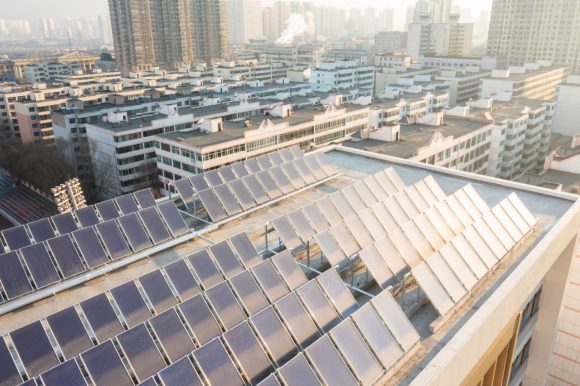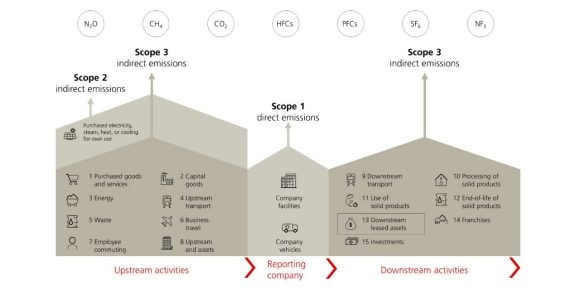Not all net-zero pathways are created equal
Improving real estate’s sustainability profile is pivotal to addressing climate change. Learn how net-zero pathways are helpful tools for comparing investment products’ climate ambitions and progress over time

Improving real estate's sustainability profile is pivotal to addressing climate change, as the sector accounts for some 40% of global greenhouse gas emissions.¹ But, as Peer Petersen and Olivia Muir highlight, improving this sustainability profile isn't just an exercise in saving the world. Building owners and associated stakeholders need to establish the necessary long-term net-zero action plans to protect income streams and value, as well as to manage costs.
The current trend is toward publishing net-zero pathways
The current trend is toward publishing net-zero pathways
Investors are demanding more precise disclosures so that they can compare different investment products, not only in terms of returns and risks, but also in terms of progress toward reducing greenhouse gas emissions.
A net-zero pathway represents a product's timeline of its "path to net zero" based on the underlying real estate asset's operating emissions. Hence, such pathways are helpful tools for comparing investment products' climate ambitions and progress over time. Additionally, net-zero pathways help make the long-term decarbonization trajectory tangible, enabling real estate managers to review the impact of their planned decarbonization measures regularly.
While real estate managers in most European countries have yet to publish net-zero pathways for real estate investment products, large institutional real estate managers in Switzerland are already disclosing their pathways, and we expect this to prevail across other markets in the near term. As is so often the case, disclosure and transparency are the first necessary steps before we can assess actual progress and performance.
Disclosure alone is not enough
Disclosure alone is not enough
The devil is in the detail, though. Since there are currently no binding industry-wide standards for calculating and presenting net-zero pathways, real estate managers and investors can only loosely compare real estate products' pathways today, as approaches, parameters, and assumptions vary by product. Until industry-wide standards are established, investors should scrutinize the detailed assumptions and parameters applied by real estate managers in their net-zero pathways. Not all pathways (and disclosures) are created equal.
The three pivotal questions to ask:
The three pivotal questions to ask:
1. Which types of emissions have been considered in the net-zero pathways?
Net-zero pathways show the expected development of emission intensities over time, measured in CO2-equivalents (CO2e) per annum per reference area. When comparing projected emission intensities between products, it is vital that investors check which types of emissions and which reference area are being considered.
Owner-controlled emissions from real estate operations are defined as scope 1 or scope 2. Scope 1 emissions are direct emissions from the combustion of fossil fuels in gas or oil heating systems installed in the property itself. Scope 2 emissions are indirect emissions that arise from the purchase of district heating as well as electricity for central systems and common areas. In addition to the emissions from the operation of owner-controlled real estate, there are indirect emissions that arise from tenants purchasing electricity in their rental spaces. These scope 3 category 13 emissions (3.13) are heavily dependent on tenant activity, with limited landlord control or influence.
While it is common to compare properties by gross floor area, local market practices may differ. Since calculated emission intensities may vary widely depending on which scopes, greenhouse gas emission factors,² and reference area have been considered for the calculations, investors may need to adjust for such differences when comparing products.
2. Which data has been used to define the baseline?
Net-zero pathways start with a baseline, comprising emission intensity at the outset of the decarbonization journey in year 0. To ensure an appropriate baseline, real estate managers should strive to use measured consumption and emission data for their property. Where such measured data does not exist, which is often the case with scope 3.13 data or with newly purchased or developed properties, real estate managers may depend on estimated data (often based on extrapolating measured data from previous periods). Where consumption and emission data is completely unavailable, market standard benchmark data may have to be applied to fill any final gaps. Where sophisticated building software solutions are available, consumption and emissions may also be calculated with model estimations.
To promote data quality, real estate managers should evaluate each asset's metrics with the support of sustainability specialists, regardless of the data sourcing method used. Where in doubt about the source of applied baseline data, investors are advised to enquire regarding the detail and steps undertaken.
3. Which future decarbonization measures have been considered in the net-zero pathway?
A further component of net-zero pathways is the application of bespoke decarbonization measures for each building in the future over time, and the estimated resulting energy consumption and emission savings on property and portfolio level.
Reducing a property's energy demand can help decrease its scope 1, scope 2, and scope 3.13 emissions and is generally the first priority in any decarbonization plan. For instance, an energy upgrade of the building envelope can materially reduce a property's energy consumption. A change from fossil fuel-based heating systems to renewable heating systems helps reduce energy consumption and emissions, as do energetic improvements of the various potential technical installations within buildings. Purchasing green electricity or producing electricity on-site with photovoltaic systems is further priority after maximising energy efficiency. This list of potential measures is not exhaustive and depends on the specific nature and state of each real estate asset.
Since portfolio net-zero pathways are by nature high-level and do not give detailed insight into the considered retrofit measures in each underlying building or the way energy consumption and emission savings from retrofit measures have been calculated, it is up to investors to request detail on the methodology and calculations applied by real estate managers, including at the level of each building.
Further clarity may be needed regarding the consideration of the effects of procurement of off-site green energy and carbon offsets, which should almost always be the last resort and final step in any decarbonization plan. It is helpful to understand the degree to which a product's net-zero pathway is driven by actual on-site improvements of energy efficiency and emission reduction, and the proportion of predicted emission reductions driven by off-site purchases or offsets.
Continual effort
Continual effort
Until binding industry-wide standards have been defined for net-zero pathway calculations, investors need to scrutinize the details of applied parameters when comparing the pathways of different products.
Leading real estate managers are monitoring net-zero-related regulatory and market developments both in their home markets and internationally so that they can act and plan with foresight. It is recommended that all real estate managers verify their net-zero pathways for each property regularly and, if necessary, update the catalog of measures to ensure that the pathway's implied annual targets are achieved as each year passes.
Scope 1, 2 and 3 emissions
Scope 1, 2 and 3 emissions

Make an inquiry
Fill in an inquiry form and leave your details – we’ll be back in touch.
Introducing our leadership team
Meet the members of the team responsible for UBS Asset Management’s strategic direction.


